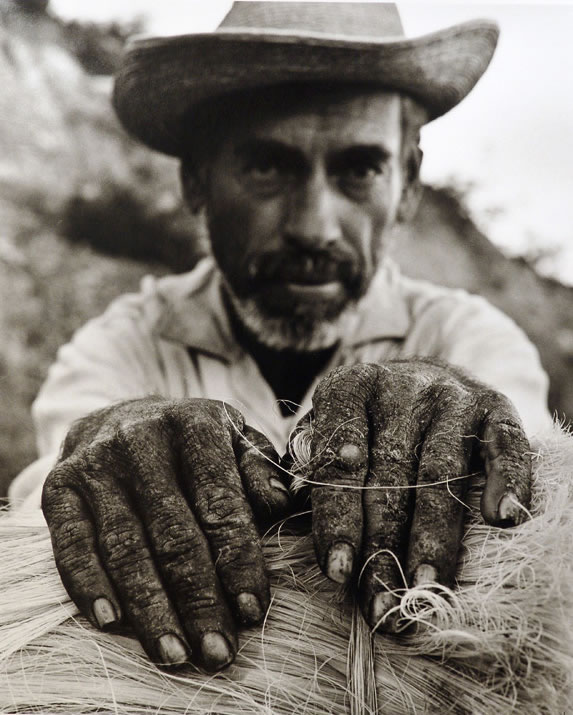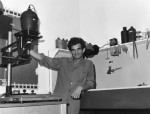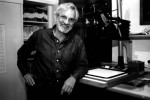

Rodrigo Moya
Mexican, 1934-
Life Isn't Beautiful, 1965, printed 2010
gelatin silver print
18 ½ x 15 in.
SBMA, Museum purchase with funds provided by PhotoFutures
2010.27

“I always approached people with a sense of tenderness and feeling. If I was photographing something, it was because I was moved somehow.” - Rodrigo Moya
“...I see that it is the country folk who are the first in line, like these men of the deserts of Coahuila, ….., with whom I lived for three days, enough time to change my perception of the world and of human society.” (“Rodrigo Moya:Photography and Conscience”, 2015).
RESEARCH PAPER
Rodrigo Moya has a deep sensitivity to his subjects, particularly to the simple, poor people in Mexico City and rural Mexico. “....he documents a painful poverty to which he is not indifferent. At the same time, a tender quality appears throughout his work: the dignity of the human being, the essence that makes us truly alike, one another.” (Arnal, p. 11). Though others may differ, Moya does not think of his photographs as art, or a medium in which he is separated from his subjects. He uses his sensitivity and connection to his subjects to create a communication between the photographer and subject, and later the viewers of his work. “Life Isn't Beautiful” is a perfect example of Moya's unique ability to allow the viewer to feel a direct communication with the subject of the picture. In spite of the ixtle gatherer's poverty, we cannot dismiss him or distance ourselves from him while in the presence of this photograph. The unasked question, Moya poses is, “Why is this man living this hard life, while others are not?”
“Life Isn't Beautiful” by Rodrigo Moya is a gelatin silver print photograph taken in 1965 for a testimonial-article, a positively inclined representation of the subject of a journalistic article, entitled Ixteleros. It portrays an impoverished ixtle gatherer who eked out a living harvesting ixtle, a hard plant fiber obtained from a variety of Mexican plants, mainly agave and yucca, used in manufacturing brushes, cords and ropes. Moya's composition and powerful perspective permits no mistaking that the hands of this worker are the focus of this photograph. In addition to the hands having the clearest focus in the picture, Moya's perspective utilizes foreshortening to draw in the viewer's gaze and give weight and size to these remarkable hands. Avoiding having your eyes drawn immediately to these hands is nearly impossible. The rough callouses, deep lines, swollen fingers and inherent strength of the fingers, along with the encrusted dirt and grime in the fingernails, speak volumes about the many years this man has endured the hard labor required to survive in this desolate, desert country. The hands on top of a pile of agave fibers further emphasizes the thickness and roughness of the fingers by juxtaposing them with the fine fibers. The detail of the individual fibers makes them seem almost delicate, except for the obvious punishing impact their coarseness has had on the man's hands over time. The desert background is somewhat fuzzy and out of focus; its austerity expressed in the bleakness of the hillside.
Moya only includes the shoulders and head of this ixtle gatherer, informing the viewer that the hands and face are Moya's main focus. This man's handsome, dignified face, his simple worker's hat and carefully trimmed beard are deeply compelling. His hands declare the narrative of a brutally harsh life and inequity of Mexican society, while we also see in the eyes and expression on this man's face, his intelligence and dignity.
The gelatin silver process employed here used with black-and-white films and printing papers, involves suspension of silver salts in gelatin that is coated onto a support such as glass, flexible plastic or film, baryta paper, or resin coasted paper. These light-sensitive materials are stable under normal keeping conditions and are able to be exposed and processed years after their manufacture, providing a photographic process for journalism before the introduction of digital photography.
Born in Columbia to a Columbian mother and Mexican father, Moya moved to Mexico as a small boy with his parents and sister. His mother was an amateur photographer, giving him an early inclination towards photography, and an interest in the image printed on light sensitive paper. Being immersed in his father's work as a theater set designer, and having easy access to his father's extensive collection of art books, taught Moya ideas about composition and framing. Moya became a photojournalist, and later, a writer and publisher. He apprenticed with the Columbian photojournalist Guillermo Angulo, becoming his apprentice and assistant at Impacto magazine while also learning from the Portuguese art critic, Antonio Rodgriguez and the Peruvian Joel Marroquin. When Angulo left to study cinema in Italy, Moya took over his position at Impacto magazine. After working there for four years, he became a free lance photojournalist. Moya became a publisher and writer, winning multiple awards for his literature, but he is best known for the photographs that he took during 1955-1968, when “Life Isn't Beautiful” was photographed.
Throughout his life, Moya was concerned with social justice for the poor in Mexico, Latin America, and the world. He studied American authors and photojournalists who shared and informed his passion for documenting social injustice and inequities. When interviewed, Moya speaks of wanting to, through his photos, document and provide testimony for those without a voice in society. He was invited to come into the jungles of Venezuela to photograph a guerrilla movement led by Che Guevara, and traveled to Cuba in 1964 to take photos of the revolution, where he famously took an iconic picture of Che Guevara smoking a cigar. He was the only Latin American photographer to cover the invasion of the Dominican Republic by the United States.
Eventually, Moya stored his photographs and negatives and moved on to a career in publishing and writing short fiction for which he won awards in literature. After suffering a long illness, at age 70, he moved from Mexico City to Cuernavaca with his wife. With the assistance of his wife, a graphic designer, and some photography experts, Moya returned to the archives of his earlier photographs. He had over 40,000 photographs and negatives in storage and only in very recent years has his work been organized and promoted.
Moya is not interested in fame. He refuses honors, prizes, and awards and prefers books about his work, rather than exhibitions. In spite of these beliefs, he received the 2007 Medal of Photographic Merit from Mexico's National System of Photographic Archives and the 2014 Presea Cervantina from the Festival Internacional Cervantino.
Produced for the Santa Barbara Museum of Art Docent Council by Joanne Singer, February, 2016.
Bibliography
(2015). “Southwestern & Mexican Photography Collection: Rodrigo Moya”. Http:///www.thewittliffcollections.txstate.edu/collections/southwestern-mexican-photography/artists/moya.html.
(2010). Capturing Castro and Che on lens. Http:/zeenews.india.com/entertainment/art-and-theater/capturing-castro-and-che-on-lens_78344.html.
Eaton, G. T. (1965). “Photographic chemistry in black-and-white and color photography”. Hastings-on-Hudson, N.Y., Morgan & Morgan.
Espinosa, Veronica (October 8, 2014. “Entregan la Presea Cervantina a Jose Sole y Rodrigo Moya”. Proceso (Mexico City). Retrieved May 11, 2015.
Hamilos, Paul (2011). “Photographer Rodrigo Moya's Best Shot”, http://.the guardian.com/artanddesign/2011/apr/06/photography-rodgrigo-moya-best-shot
Moya, Rodrigo and Arnal, Ariel, (2015). “Rodrigo Moya: Photography and Conscience”. University of Texas Press: Austin, Texas.
“Rodrigo Moya (Mexican, 1934-)”. Etherton Gallery. Retrieved May 11, 2015.

Photo by Rodrigo Moya, Che Melancolico, Cuba, 1964
COMMENTS
Mexican photographer Rodrigo Moya covered political unrest throughout Latin America during the 1950s and 1960s. As a young photographer, he discovered the work of Walker Evans, Lewis Hine, Robert Frank, Eugene Smith, Dorothea Lange and the Farm Security Administration (FSA), as well as American magazines, such as American Photography, US Camera and Life, and was influenced by Mexican photographer Nacho López. Part photojournalist, part street photographer, Moya brought the human cost of civil and military uprisings and the people who lived through these turbulent times to the pages of magazines such as Impacto, El Espectador, Politica, Sucesos and Siempre! Much of the photographer’s work draws deeply from the lives and aspirations of the rural and working classes he encountered while working as a writer and photojournalist throughout Mexico and Latin American for more than three decades. While in Cuba, Moya took a series of photographs of Ché Guevara, and in 1965, he was the only Latin American photographer to cover the invasion of the Dominican Republic and the battle for Santo Domingo. Although he never considered himself a war photographer, the social conflicts created by brutal dictatorial regimes found expression through his camera. Throughout his career, he used his assignments as opportunities to photograph subjects he found personally interesting or moving.
In 1967, Moya ended his photography career and started a small publishing enterprise, eventually becoming an acclaimed writer of short fiction. He wrote de lo que pudo haber sido (What Could Have Been in 1996, and the book Cuentos para leer junto al mar (Tales to be Read by the Sea), which won a Mexican national literary award in 1997. Recently, after overcoming a serious illness, he rediscovered photography. His work has been the subject of publications, including Fuera de Moda: Homenaje: Obra Fotografica, 1955-1968 (2002); a monograph Rodrigo Moya; foto insurrecta (2005); and Rodrigo Moya: Una Vision Critica De La Modernidad (2006). In 2007, he was awarded the Medal of Photographic Merit by Mexico’s National System of Photographic Archives. In 2009 he was the subject of a documentary film Conciencia de luz: Rodrigo Moya, Fotógrafo.
Rodrigo Moya’s work is in the permanent collections of the San Francisco Museum of Modern Art, the Museum of Fine Arts, Houston, the Nelson-Atkins Museum, the Santa Barbara Museum of Art, the Wittliff Collections, and the Center for Creative Photography, University of Arizona.
http://www.ethertongallery.com/html/artist_detail.php?recordID=6
